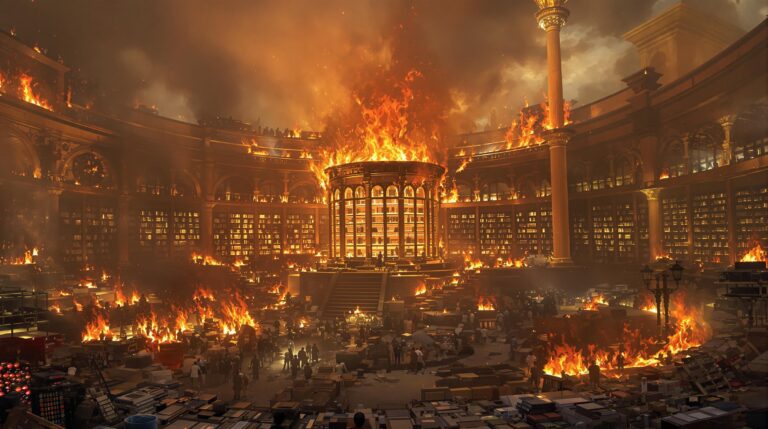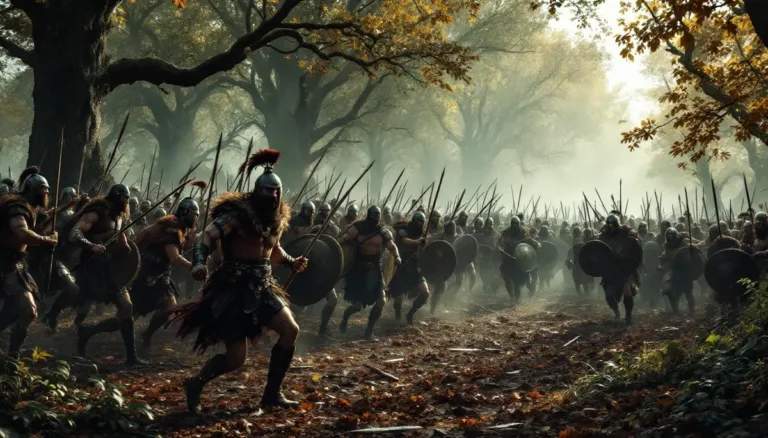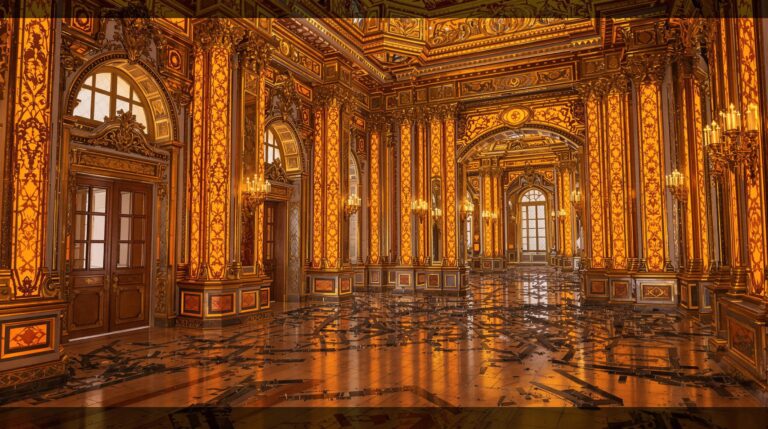The Dancing Plague of 1518
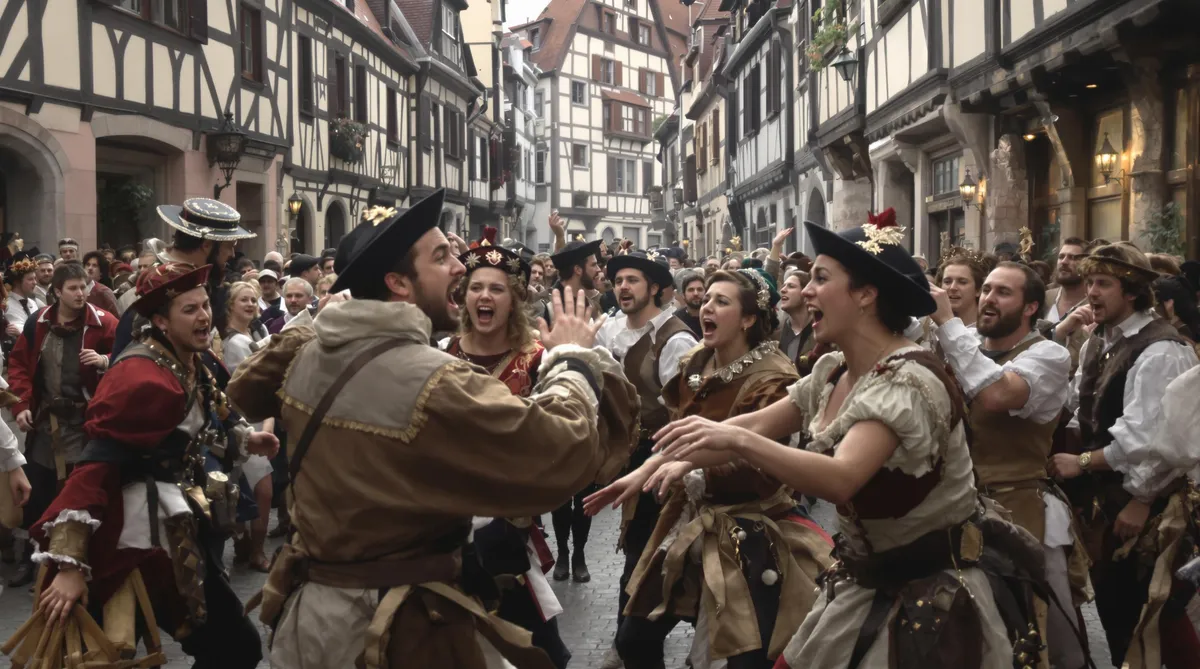
In July 1518, a peculiar incident unfolded in Strasbourg, enchanting the attention of historians and psychologists alike.
A woman named Frau Troffea initiated a frenzied dance that soon engulfed hundreds.
This bizarre occurrence raises questions about the interplay between societal stressors and collective behavior. What drove these individuals to succumb to such uncontrollable urges?
Understanding the underlying factors could shed light on not only this event but also the complexities of human response under pressure.
TL;DR
Hide- The Dancing Plague began in July 1518 in Strasbourg, triggered by Frau Troffea, leading to mass uncontrollable dancing among hundreds.
- Symptoms included extreme physical exhaustion, distorted expressions, and in some cases, collapse or death from relentless movement.
- Theories explaining the epidemic include mass hysteria, ergot poisoning from contaminated rye, and religious fervor seeking divine forgiveness.
- Local authorities mistakenly believed music would cure the dancers, resulting in hired musicians and stages, reflecting a misunderstanding of the crisis.
- The event symbolizes societal rebellion against pressures, illustrating how collective trauma can manifest in irrational behavior and mass psychogenic illness.
The Dancing Plague of 1518: A Strange Epidemic Emerges in Strasbourg
In the summer of 1518, Strasbourg, a city marked by both prosperity and underlying anxiety, became the epicenter of a perplexing epidemic.
The inexplicable dance of Frau Troffea, patient zero, catalyzed a widespread compulsion that ensnared hundreds, raising questions about the interplay of societal stressors and individual behavior.
This strange occurrence invites reflection on how collective emotions can manifest in unforeseen and sometimes tragic ways.
Strasbourg: City of Prosperity and Anxiety
Amidst the backdrop of burgeoning prosperity in 16th-century Strasbourg, an undercurrent of anxiety pervaded the community, setting the stage for an extraordinary epidemic.
Economic growth and urban development masked deeper societal tensions, creating fertile ground for unrest.
- Food shortages heightened stress among citizens.
- Disease outbreaks further strained the populace.
- Religious fervor added a mystical dimension to their fears.
- Social inequalities exacerbated feelings of helplessness.
This volatile mix of prosperity and anxiety catalyzed the emergence of the Dancing Plague, as individuals sought solace in collective expression.
The phenomenon reflected a broader human struggle, revealing how deeply embedded anxieties can manifest in unpredictable ways.
The city’s duality—of wealth and worry—foreshadowed the chaos that would soon unfold.
Frau Troffea: Patient Zero’s Mysterious Dance
Frau Troffea, the enigmatic catalyst of the Dancing Plague, ignited a frenzy that would ensnare Strasbourg in chaos.
Her inexplicable urge to dance in the summer of 1518 marked the inception of a bizarre epidemic, capturing the attention of a populace already burdened by anxiety.
As her movements spiraled into a communal frenzy, the streets became a stage for a tragic spectacle, where hundreds succumbed to the compulsion, dancing relentlessly.
Local authorities, desperate for control, misdiagnosed the phenomenon as a need for more music, reflecting their inability to comprehend the psychological turmoil at play.
This mass hysteria underscores the fragility of collective human experience, prompting contemporary reflection on the nature of societal pressures and the unseen forces that can drive communities to madness.
From One Dancer to Hundreds: An Unstoppable Frenzy
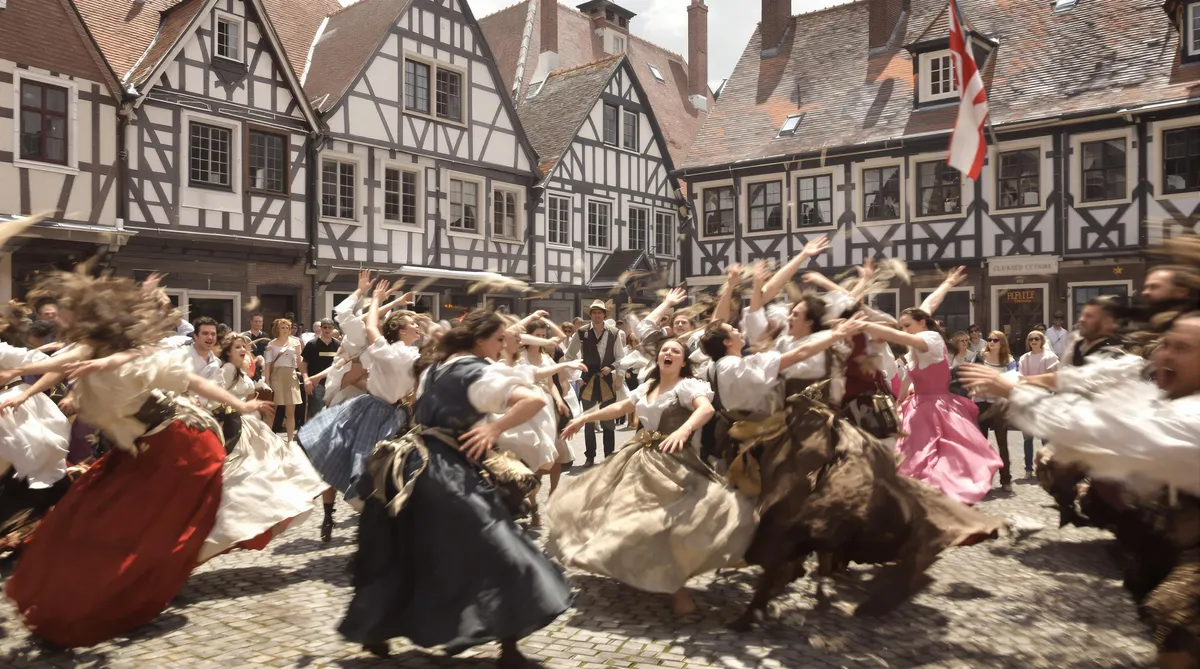
As the initial episodes of the Dancing Plague unfolded through the actions of Frau Troffea, the phenomenon rapidly escalated, transforming individual symptoms into a collective frenzy that captivated the city of Strasbourg.
Witness accounts reveal a chilling blend of ecstasy and despair, while the authorities’ response—erecting stages and hiring musicians—reflects a desperate attempt to reclaim control over a situation that seemed to defy reason.
This peculiar intersection of perceived possession and societal panic raises profound questions about the nature of collective behavior and the human psyche’s vulnerabilities during times of crisis.
Symptoms or Possession? Accounts of Witnesses
While the origins of the Dancing Plague remain shrouded in mystery, the accounts of witnesses from that time provide a chilling glimpse into the frenzied experience of those affected.
The descriptions varied widely, leading to speculation about whether the dancers were suffering from symptoms of a physical ailment or were under some form of possession.
Witnesses noted:
- Uncontrollable movements as if compelled by an unseen force.
- Distorted expressions, often reflecting terror or ecstasy.
- Physical exhaustion leading to collapse, sometimes resulting in death.
- A contagious nature, where bystanders felt an inexplicable urge to join in.
These accounts fuel ongoing debates about the psychological and social implications of the event, highlighting the thin line between hysteria and genuine affliction.
The City’s Unusual Response to the Epidemic
Amid the chaos of the Dancing Plague, the city of Strasbourg found itself grappling with a crisis that defied conventional understanding.
In a desperate bid to quell the contagion, local authorities adopted an unconventional approach: they constructed stages and employed musicians, believing that encouraging the dancers would somehow alleviate their affliction.
This response reflected a profound misunderstanding of the situation, treating the epidemic as a mere entertainment opportunity rather than a complex psychological phenomenon.
The irony lay in the fact that their efforts only fueled the frenzy, demonstrating how societal responses can sometimes exacerbate crises.
Ultimately, this perplexing episode reveals the intricate interplay between fear, community, and the human psyche, prompting reflection on how societies navigate collective distress.
Historical Context: Life in Early 16th Century Alsace
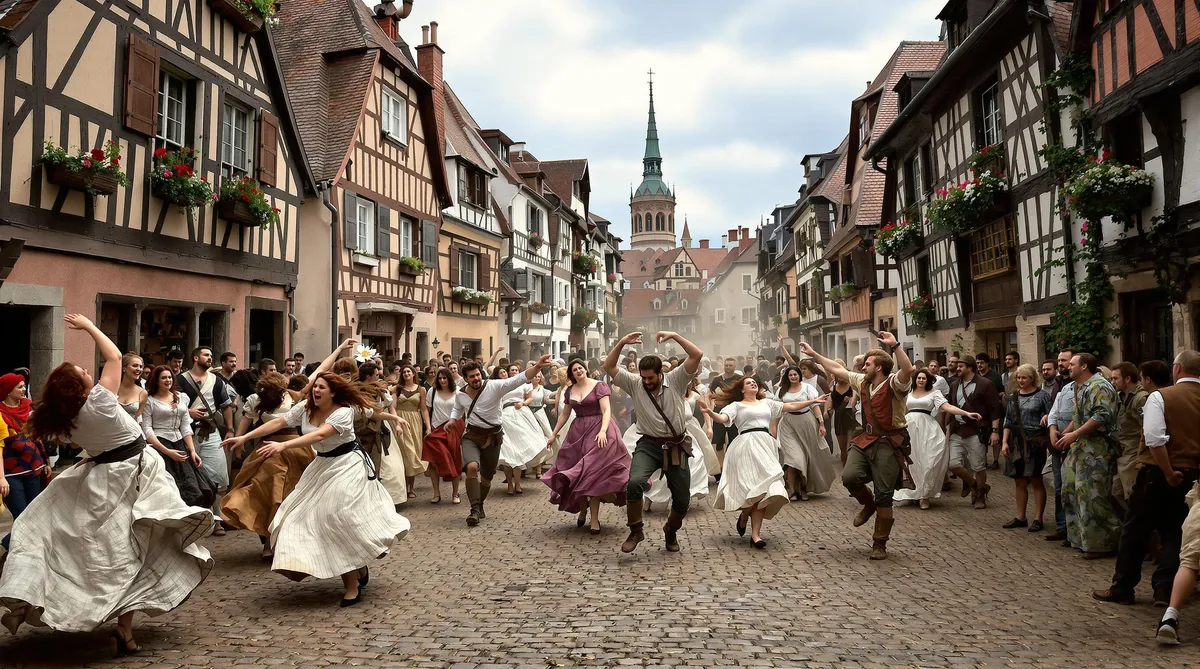
In the early 16th century, Alsace was a region marked by socioeconomic instability, with frequent famine and disease exacerbating the struggles of its inhabitants.
Amid this turmoil, the pervasive fear of divine retribution loomed large, shaping community behaviors and beliefs.
These factors created a fertile ground for collective psychological phenomena, such as the Dancing Plague, where societal stressors could manifest in bewildering ways.
Socioeconomic Pressures and Their Impact
As the summer of 1518 unfolded in Strasbourg, the convergence of socioeconomic pressures considerably shaped the lives of its inhabitants, creating an environment ripe for psychological distress.
The populace faced numerous challenges, including:
- Famine: Poor harvests intensified food scarcity, driving desperation.
- Disease: Frequent outbreaks undermined public health, breeding anxiety.
- Political Instability: Power struggles among local authorities eroded trust and security.
- Economic Strain: Rising taxes and unemployment exacerbated financial woes.
These factors interwove to foster an atmosphere of collective tension, leading individuals to seek solace in the inexplicable.
The resultant psychological strain manifested as the Dancing Plague, illustrating how deeply rooted socioeconomic factors can precipitate extraordinary human behaviors, revealing the fragile balance between societal pressures and personal well-being.
Religious Turmoil: The Fear of Divine Wrath
While the summer of 1518 brought forth the haunting spectacle of the Dancing Plague, the religious landscape of early 16th century Alsace was equally tumultuous, shaped by an undercurrent of fear regarding divine retribution.
The Reformation was unraveling traditional beliefs, prompting apprehension about sin and punishment. Many viewed the plague as a manifestation of God’s wrath, a direct response to societal failings and moral decay.
This environment of anxiety amplified the psychological distress among the populace, blurring the lines between the sacred and the profane.
As individuals grappled with existential dread, the compulsion to dance became a chaotic expression of their inner turmoil, reflecting a desperate need for divine intervention, solace, and ultimately, liberation from their fears.
Theories Behind the Mysterious Phenomenon
The Dancing Plague of 1518 has sparked numerous theories attempting to explain its origins, each offering a unique lens through which to view this bizarre episode.
Some scholars suggest that mass hysteria may have driven individuals to dance uncontrollably, while others propose that ergot poisoning from tainted bread could be to blame.
Additionally, the possibility of religious ecstasy as a form of seeking divine forgiveness adds another layer of complexity to this historical enigma, prompting inquiry into how psychological and environmental factors intertwined in this extraordinary event.
Mass Hysteria: Psychological Contagion at Play?
Although the origins of the Dancing Plague of 1518 remain elusive, the phenomenon can be examined through the lens of mass hysteria and psychological contagion.
This event illustrates how anxiety can ripple through a community, compelling individuals to engage in irrational behaviors.
Key elements contributing to this phenomenon include:
- Collective stress from societal pressures and hardships.
- Social isolation exacerbating feelings of helplessness.
- The influence of charismatic leaders or peers fostering conformity.
- The power of shared beliefs amplifying emotional responses.
These factors intertwine, creating an environment where fear and excitement coexist, leading to a collective breakdown of rational thought.
The Dancing Plague serves as a compelling reminder of humanity’s susceptibility to psychological phenomena, echoing through the ages.
Ergot Poisoning: Could Bread Cause Madness?
Amid the backdrop of collective stress and psychological contagion, another theory emerges regarding the Dancing Plague of 1518: ergot poisoning.
This hypothesis suggests that the rye bread consumed by the afflicted may have been contaminated with ergot, a hallucinogenic fungus. The psychoactive compounds in ergot can induce symptoms such as spasms, hallucinations, and a compulsion to move.
As starvation gripped the region, reliance on contaminated grain could have led to widespread ingestion of the toxin. This theory raises important questions about the interplay between physical substances and mental states, challenging the notion of madness as purely psychological.
If ergot indeed fueled the frenzy, it underscores how environmental factors can profoundly influence human behavior, blurring the lines between mind and body in moments of crisis.
Religious Ecstasy: A Dance for Divine Forgiveness?
What drove the people of Strasbourg to dance uncontrollably during the summer of 1518? One theory suggests that the phenomenon was rooted in a search for divine forgiveness, as the community faced dire circumstances.
This collective longing may have manifested in the following ways:
- Religious fervor: The desperate populace sought absolution through ecstatic movements.
- Cultural practices: Dance was a historically significant form of worship, possibly reemerging in crisis.
- Social pressure: Witnessing others dance may have fueled a contagious desire for salvation.
- Psychological release: The act of dancing could have served as an outlet for pent-up anxieties and frustrations.
Thus, the Dancing Plague might represent an intersection of faith, desperation, and human emotion, revealing deep-seated yearnings for liberation in the face of adversity.
Historical Records and Personal Accounts
Historical records from physicians and clerics provide an essential lens through which to examine the Dancing Plague of 1518, revealing societal reactions and medical interpretations of the event.
Artistic representations from the time further enrich this narrative, capturing the chaos and fervor experienced by those caught in the frenzy.
Together, these accounts invite reflection on the interplay between observed phenomena and the cultural context that shapes their understanding.
Chronicles of Physicians and Clerics
As the Dancing Plague of 1518 unfolded in Strasbourg, physicians and clerics found themselves thrust into a bewildering crisis that defied their understanding of medicine and morality.
Their chronicles reveal a society grappling with chaos, where rational thought was overshadowed by superstition. They documented:
- The desperate attempts to diagnose a condition that seemed inexplicable.
- The calls for divine intervention, as faith was seen as a remedy.
- The absurdity of hiring musicians, believing music would quell the frenzy.
- The growing despair as the death toll rose amidst relentless dancing.
These accounts illuminate the struggle between reason and hysteria, reflecting a community in turmoil—a poignant reminder of how humanity often seeks clarity in the face of the unfathomable.
Artistic Interpretations: What Did the Artists See?
How did the artists of the time interpret the inexplicable chaos of the Dancing Plague? They transformed the unsettling spectacle into vivid imagery, capturing the frenetic energy and despair that enveloped Strasbourg.
Paintings often depicted chaotic crowds, limbs entwined in a frenzied dance, reflecting an intense struggle between joy and suffering.
Artists, influenced by prevailing beliefs in the supernatural, infused their work with symbolic elements, suggesting divine punishment or mass hysteria.
This artistic lens offered a window into the societal psyche, emphasizing the collective fear and vulnerability of the populace.
Through their creations, these artists not only documented a historical anomaly but also invited contemplation on the nature of human experience, revealing how chaos can inspire both beauty and tragedy.
Cultural Reflections and Symbolism
The Dancing Plague of 1518 serves as a powerful metaphor for human rebellion against societal pressures and existential despair.
In its chaotic rhythm, one can find echoes of folklore and legend, with the event resonating through popular culture as a cautionary tale of collective madness.
This peculiar episode invites reflection on how cultural narratives shape our understanding of shared trauma and the human experience.
Dancing as Metaphor: Rebellion or Desperation?
While many may view the uncontrollable dancing of 1518 as merely a peculiar historical event, it also serves as a profound metaphor for the human experience, encapsulating themes of rebellion and desperation.
The phenomenon reflects how collective action can emerge from individual despair, revealing deep-rooted societal tensions. This interplay can be understood through four key aspects:
- Rebellion against authority: The dancers defied societal norms, showcasing a yearning for freedom.
- Desperation for relief: Their movements echoed a collective cry for help amidst suffering.
- Expression of communal identity: The dance unified individuals, highlighting shared struggles.
- Conduit for emotional release: The act transcended mere movement, embodying pent-up frustrations.
In this light, the Dancing Plague becomes a powerful symbol of humanity’s relentless quest for liberation.
Folklore and Legend: The Dancing Plague in Popular Culture
Although the Dancing Plague of 1518 may seem like an isolated historical oddity, its echoes have permeated popular culture, illustrating how folklore can shape societal narratives.
The tale serves as a metaphor for collective anxiety, often resurfacing in literature, music, and art as a symbol of societal unrest. Films and novels have drawn on its eerie energy, using the dance as a canvas for exploring themes of madness and liberation.
This phenomenon reflects humanity’s fascination with the irrational, compelling audiences to confront their own fears and societal pressures.
As modern crises unfold, the Dancing Plague endures as a cautionary legend, inviting reflection on how collective experiences—be they joyful or traumatic—can shape cultural consciousness and personal identity.
Modern Scientific Insights and Explanations
The Dancing Plague of 1518 serves as a compelling case study for understanding collective behavior and its psychological underpinnings in contemporary contexts.
Modern scientific investigations suggest that the phenomenon can be viewed through the lens of mass psychogenic illness, illustrating how communal anxiety can lead to extraordinary actions.
Understanding Collective Behavior Today
How do collective behaviors emerge and evolve within communities today?
Modern insights reveal that these phenomena often arise from shared emotions, social dynamics, and cultural contexts.
Four key factors contribute to the emergence of collective behaviors:
- Social Media Influence: Rapid information spread amplifies emotions, leading to widespread reactions.
- Emotional Contagion: Individuals often mimic the feelings and actions of those around them, fostering group solidarity.
- Crisis Situations: High-stress environments can trigger collective responses, as seen in protests or public gatherings.
- Cultural Narratives: Shared beliefs and historical contexts shape group behaviors, making certain actions more likely.
Understanding these dynamics allows for a deeper appreciation of human interconnectedness and the complexities of societal responses.
Medical Investigations into Historical Epidemics
While examining historical epidemics, modern scientific investigations have uncovered a wealth of insights that illuminate the complexities of human health and societal responses.
The Dancing Plague of 1518 exemplifies how collective phenomena can arise from psychological stimuli rather than purely biological causes.
Research suggests that mass psychogenic illness, fueled by societal stressors like famine and disease, contributed to the outbreak.
This perspective shifts the focus from individual pathology to communal dynamics, revealing how fear and anxiety can catalyze irrational behaviors. Such insights promote understanding of human resilience and vulnerability.
Mystery Remains: Questions We Still Ask Today
The enigma of the Dancing Plague raises profound questions about the nature of human behavior and collective psychology.
Could such an extraordinary event reoccur in today’s world, where social pressures and anxieties are amplified by technology?
Additionally, what lessons does this historical episode offer regarding the dynamics of fear and mass response in contemporary society?
Could the Dancing Plague Occur Again?
What factors could potentially ignite a similar phenomenon to the Dancing Plague in today’s society?
Modern life, with its complexities and pressures, could foster conditions ripe for mass hysteria. Four elements stand out:
- Social Media Influence: Viral trends can amplify collective behaviors rapidly, creating a shared experience that spirals out of control.
- Psychological Stress: High levels of anxiety and trauma, exacerbated by global crises, may lead to contagious psychological responses.
- Isolation: Social disconnection can heighten feelings of despair, triggering unexplainable collective reactions.
- Cultural Echoes: Historical narratives can inspire reenactments of past phenomena, blending reality with myth.
Ultimately, understanding these factors may help society mitigate potential outbreaks of collective mania in an increasingly chaotic world.
What Does the Dancing Plague Teach Us About Human Behavior?
How does a collective experience transform individual behavior into something unrecognizable? The Dancing Plague of 1518 serves as a poignant example of this phenomenon, illustrating how societal pressures and shared anxieties can catalyze mass hysteria.
In a climate marked by famine and disease, the compulsion to dance infected hundreds, revealing the fragility of human psyche under duress.
This event underscores the interplay between individual agency and collective emotion, suggesting that fear or stress can transcend rational thought, leading to irrational behaviors.
As modern society grapples with its own challenges, the Dancing Plague prompts reflection on how communal experiences shape actions. What may appear ludicrous in hindsight often reveals deeper truths about human nature and the complexities of social dynamics.
Wrapping Up
The Dancing Plague of 1518 stands as a demonstration to the frailty of the human psyche under societal pressures.
As the adage goes, “desperate times call for desperate measures,” the chaotic response of authorities only fueled the frenzy.
This event invites reflection on the intricate interplay between collective behavior and cultural anxieties, highlighting how fear and uncertainty can manifest in unexpected ways.
The mystery lingers, prompting ongoing inquiry into the depths of human experience and the nature of mass hysteria.
